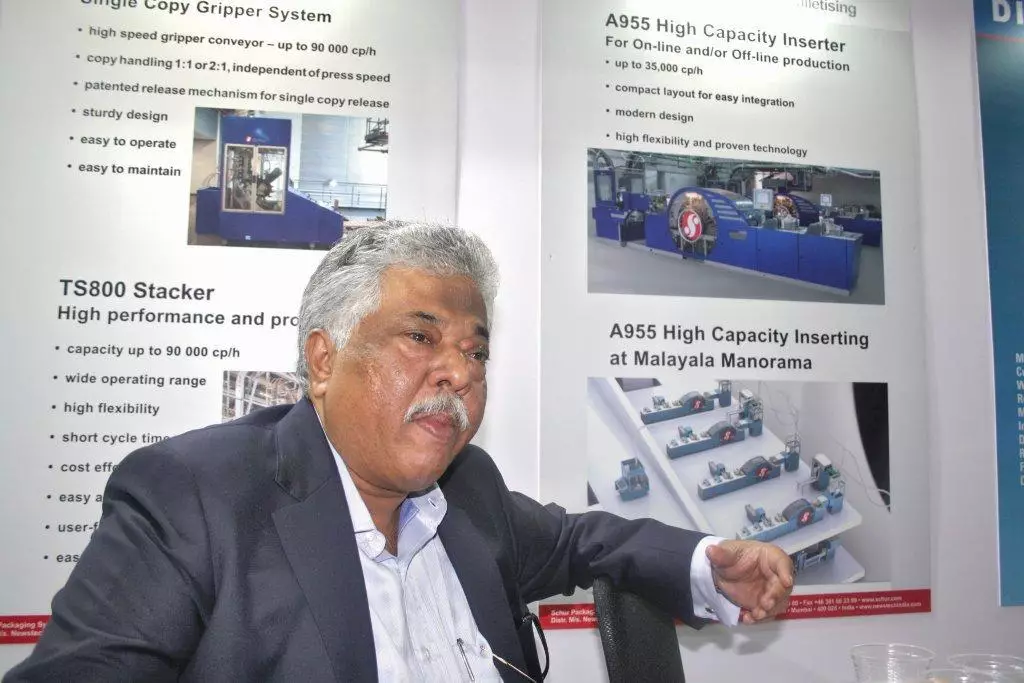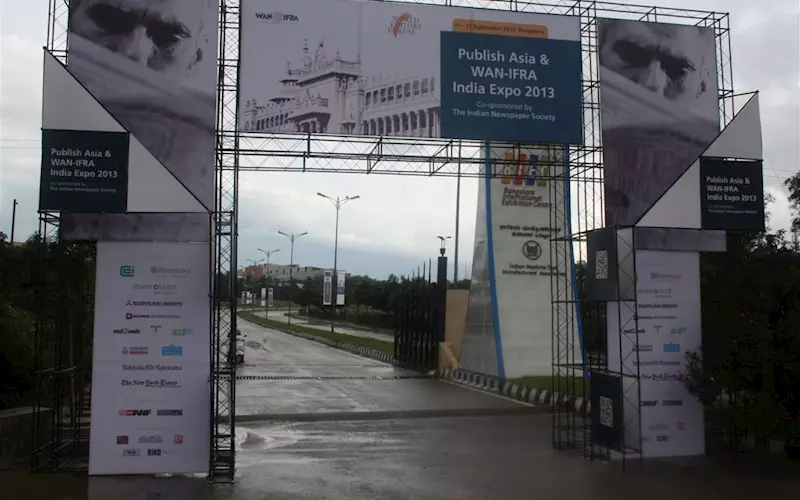Wan-Ifra in Bengaluru from 11 to 13 September provided a jolt of optimism, and a chance to focus, which the Indian newspaper industry requires. The show highlights by Ramu Ramanathan.
It’s a bit easy to become pessimistic about the print industry. This was evident at Wan-Ifra in Bengaluru. The three day Publish Asia conference had 550 registered delegates but the number of exhibitors at the show was tiny. Everyone attributed it to three things: the rupee, the paralysis in government and how it is wait and watch till the elections for the 16th Lok Sabha. But beneath the negative sentiment, the numbers look good. The head of a firm that manufactures UV curing systems speaks of the good run his firm has with two newspapers in the south who deploy UV curing on web offset newspaper presses where coldset inks are used.
A short walk around the exhibition and one heard rumours about intense lobbying to ward off the threat of a hike in imported newsprint.
The third thing, according to a CII and PriceWaterCooper report, the media and entertainment industry is expected to exceed Rs 2,24,500 crore growing at a CAGR of 18% from 2012 to 2017. Today, the size of the Indian M&E sector increased from about Rs 805 billion in 2011 to almost Rs 965 billion in 2012 representing a year-on-year growth of 20%. The print sector revenues are expected to increase at over 9% CAGR to reach Rs 331 billion in 2017 from Rs 212 billion in 2012. The print sector contributed to 22% of the revenues of M&A industry in 2012. However, the share of print is likely to decrease to 15% in 2017.
Highlights from Wan-Ifra
Made in India scores
Manugraph has a huge order from Seculo Printers. In 2001, the Seculo Group in South African opted for a raft of Heidelberg presses and by 2006 a new Hiline Manugraph press was installed. Recently, the group has ordered a new Cityline Express from Manugraph. As Paula Caetano, president at Seculo Group said, “The Seculo Group was looking for a reliable printing press that is compatible to our existing Goss and Hiline coldset machines that are more mechanically orientated rather than electronic. The Manugraph Cityline Express, 32-page tabloid full colour have two folders, which we can use for two different jobs up to an eight-page broadsheet. It also gives us flexibility and excellent multicolour printing quality.”
TPH has bagged new orders for presses in India and overseas
There’s similar news from Faridabad-based The Printers House (TPH) on the international front. In the last quarter, TPH has bagged three new orders and successfully commissioned two printing presses. George Kuriakose, AGM for sales at TPH is unwilling to disclose the names of the clients other than saying; one project is “the neighbouring country”; and the others are in the Middle East and North Africa.
Ronald Web Offset, manufacturer of the Ronald brand of web offset presses, has multiple orders in Japan (16-page, broadsheet) and Turkey (64-page, with 50% colour).

Ronald has orders in Japan and Turkey
The Guptas who were manning the stall, said, “There is a huge market for automated equipment in India; especially in the book printing segment”. This is where the firm has seen traction. At the moment, newspapers dominate 80% of the orders; and book printing accounts for 20%. But these numbers may see a shift, said the Ronald team.
Mailroom developments
On the mailroom front, Kawal Arora spoke about how the Anandabazar Publishers (ABP) have installed a range of Ferag mailroom systems at their Kolkata print plant. This includes four UTR universal conveyors and eight MultiStack compensating stackers, each with a SmartStrap cross strapping machine.

Arora spoke on mailroom installations at ABP
Arora added, Ferag has installed mailroom equipment at Mathrubhumi at 10 print locations units across Kerala. This would be systems for both the TKS double-width press (75,000 cph) and Manugraph’s Newsline (45,000 cph). The Thiruvananthapuram unit boasts of a “single gripper conveyor UTR, multi-stack stackers, top sheet printing, automated high speed online inserters, film wrappers and cross strappers.” Arora reaffirmed that twelve lines will be finally installed at Mathrubhumi. He also mentioned a project with The Times of India in Kolkata and Chennai.

Alex Roy: “Creating mailroom systems for India”
Meanwhile Roy Alex of Newstech said the project to implement 26 inserting lines at Malayala Manorama is “on track”. This order created a stir two years ago, as “the world’s biggest inserter order ever with Schur Packaging Systems”.
Alex said, “Malayala Manorama, the leading Malayalam language regional newspaper with 10 printing plants in Kerala has a mailroom which includes inserting, programmed bundling. This has been bundled with their Smartline and Frontline presses from Manugraph.”
What makes this order of 26 inserting system with a capacity of 35 000 cph each, 13 folder grippers of the new model TGG 3200, 13 TS 800 stackers and NTTS 300 stacker based 26 stack-pack lines special is, it is locally manufactured in Newstech’s unit in Turbhe (near Mumbai).
Small but important innovations
Afsal Kottal of Percept, said, “The feedback from customers is constant. It is all about better performance and speed.”
This is the reason, Mathrubhumi, Malayala Manorama, Deccan Chronicle, Dinakaran, Daily Thanthi, Deshabhimaani, Sakal and Hitwada deploy GMG Color Servers. This was demonstrated with print samples. The publishing houses which worked with GMG’s Color Server were able to avoid faulty colours; and more importantly reproduce specific printing standards on all types of substrates.
Kottal said, “Colour can be measured. This reduces press time, saves inks and maintains standard densities.” He felt, with the colour systems from GMG, Indian newspaper houses have arrived; and are “no longer on the cusp of the colour revolution.”
Kottal explained that “GMG has successfully implemented making the colours same as coated paper – in all paper types as well as printing process. This is because coated results is what a designer will see on his calibrated monitor and will be closest to the original product.”
Then there was Dial-A-Vend by Shakti Udyog which was running live at their stall. The Tamil newspaper Dinamalar has 25 of these machines at real sites in Tamil Nadu. S Vijay of Shakti who launched this kit at Wan-Ifra in 2011 says, “The Dial-A-Vend stands out because it’s not like an imported snack vending machine.” The kit has a programmable coin mechanism and it is networked. Vijay explained during a demo, how “it can provide real-time reports and analytics”. The USP is the ability of the vending machine to provide signage space and provide branding for both Dinamalar and the publisher’s advertiser.
Vijay said, “Dial-A-Vend can do monitoring and diagnostics. If the number of copies in a particular site are less, a message is sent to the site. Now we are using this data to do prognostics like daily sales, locational traffic, machine health, customer data and re-fill status. Plus we can offer competitive pricing by proactively changing the cover price in the evening.”

TechNova’s newspaper portfolio
Also there was TechNova with its Metijet and the newly launched GreenJet. TechNova has been eyeing the newspaper segment with its iCTP systems and Metijet in the past few months. The system uses an Epson inkjet system with 720 dpi. One notable customer is, Deshabhimani which has six locations in Kerala. The Deshabhimani at its Thiruvananthapuram unit uses PosiJet film, while units at Kottayam, Mallapuram, Kannur, Calicut and Trichur use MetiJet. The Kannur unit uses thermal CTP plates.
Apart from Deshabhimani, the other TechNova users are Kerala Kaumudi in Kollam, Madhyamam, Thejus and Siraj Daily in Calicut, who use PosiJet films.
Deepak Chawla, of TechNova Imaging Systems, said, “Newspapers use a mix of PosiJet inkjet film for making positives and use this film to expose PS plates. MetiJet PS inkjet aluminium plate is directly imaged from inkjet platesetter.”
Our view
Even though the response from the manufacturers and vendors was lukewarm at the BIEC trade fair ground in Bengaluru, we expect lot more news from the Wan-Ifra edition in Berlin in the first week of October.

Several Indian newspaper houses deploy GMG’s Color Server

















 See All
See All